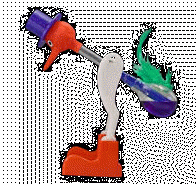|
Current and Potential Difference
Objectives
• Know that current is the
rate of flow of
charge.
• Know that
voltage is the energy given to these charges.
• Be able to select and use the equation
I = Q ÷ t
to solve problems involving the flow of charge in a circuit.
Task 1
Remind the person next to you:
• What are the two types of electrical charge?
• What does the word static mean?
• What does it mean if an object is charged?
• What does it mean if an object is uncharged?
Task 2
Your teacher will show you the simulation below to show you
how changing the potential difference (voltage) affects
the rate of current flow.
n.b. there is also a local copy stored
here.
Discuss with the person next to you:
• Which type of charge is flowing in the circuit?
• Is the charge used up as it flows around the circuit?
• What does the charge carry with it? Is this used
up?
• What effect does changing the voltage have on the
current, and why?
Task 3
Your teacher will give you a
copy of the text
below. Stick it into your book, and fill in the missing words.
| Current is the flow of
electrical _____________. There are two types of these
electrical _____________, which are p_____________ and
n_____________. It is the ______________ charges which flow in a
circuit because they are ______________ and _______________ and
so can move more easily. These charges are called _____________.
A cell or _______________ gives the charges
the _____________ to flow around the circuit. This ____________
is carried to the components, where it is used up, but the
charge itself does not get used up! The greater the
______________ of the cell, the more energy the charges get, and
the ______________ the current that will flow. We think of
“conventional current” as flowing from _____________ to
_____________, but in fact the electrons flow from
_______________ to _____________!
Current is measured using an
__________________, which is connected into the circuit in
_______________. Voltage is measured using a __________________,
which is connected across the component in ______________.
|
Task 4
The amount
of charge flowing in an electrical circuit is measured in units called "Coulombs"
(a Coulomb is actually a very large amount of charge - about 6 million
million million electrons).
The rate of flow of charge, known as the
current, is measured in Coulombs per second - also known as "Amperes".
|
I =
Q ÷ t |
I =
current, measured in Amperes (A)
Q = charge,
measured in Coulombs (C)
t = time, measured
in seconds (s)
|
Complete the calculations on page 1 of
this sheet.
Task 5
The charges have energy when they leave the battery or
power supply. They use this energy as they flow around the
circuit. We say the charges "do work" as they flow around.
The amount of energy carried by the charges, and hence the amount of
work done, is known as the potential difference (or
"voltage"), measured in Volts.
A potential difference of 1 Volt means that each Coulomb
of charge carries 1 Joule of energy (1 V = 1 J/C)
|
E =
Q × V |
E =
energy, measured in Joules (J)
Q = charge,
measured in Coulombs (C)
V = potential
difference, measured
in Volts (V)
|
Make a note of the formula in your exercise book and
complete the questions on the second page of the worksheet.
Homework
No homework this lesson
|

